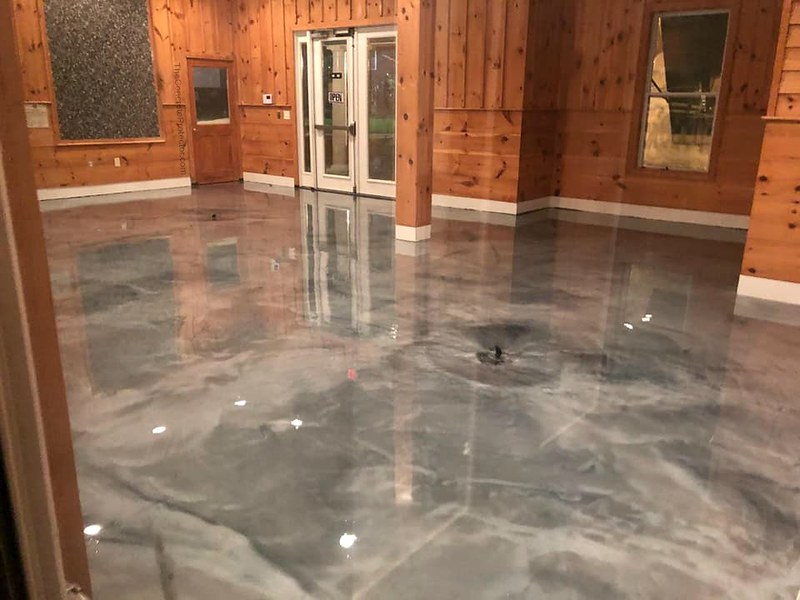Polymeric flooring
Metallic marble epoxy flooring from Creative Concrete Coatings.
[edit] Introduction
The term ‘flooring’ refers to the lower enclosing surface of spaces within buildings. This may be part of the floor structure, such as the upper surface of a concrete slab or floor boards, but typically it is a permanent covering laid over the floor. There are many types of flooring materials available. For more information see Types of flooring.
Resilient flooring is loosely defined as flooring manufactured from elastic materials. Products made out of these materials share certain characteristics - they are durable and firm, but they also offer a degree of 'bounce' or resilience. For more information see Resilient flooring.
[edit] Polymers and flooring
One type of resilient flooring is polymer. A polymer is a substance which has a molecular structure built up chiefly or completely from a large number of similar units bonded together. In basic terms, polymers are very long molecules typically made up of many thousands of repeat units.
Many synthetic and organic materials are based on polymers, including; plastics, rubbers, thermoplastic elastomers, adhesives, foams, paints and sealants. Polymer materials account for the highest growth area in construction materials. Well-established applications of polymers in construction include products used for flooring, windows, cladding, pipes, membranes, seals, insulation, and so on. With thousands of commercially available polymers new applications are emerging all the time.
Polymeric floors are poured as liquids and spread out across surfaces to harden and cure. This creates a finish without seams and makes them particularly suitable for industrial or commercial applications.
Examples of polymer materials in flooring include:
- Epoxy flooring (including solid resin and terrazzo flooring) is a combination of polymer resins and hardeners that form a single cohesive material that is at least 2mm thick (otherwise it is known as epoxy coating). It is not only durable but can also cope with harsh usage. It increases the strength and durability of concrete and protects the floor from chemicals. It can also increase the light reflectivity of the floor and bonds easily with cement or concrete.
- MMA (methyl methacrylate) resin flooring is a dual system polymer able to withstand weak acids and other solvents. Epoxy has a gentler cure rate as compared to MMA (methyl methacrylate) floors, and it requires more than one coat to remove porosity of the concrete.
- Urethane (and urethane concrete) flooring systems (also known as polyurethane flooring systems) are used to treat concrete floors and enhance their chemical, water, slip and abrasion resistance.
The introduction of polymeric materials has brought with it new concerns, particularly relating to their longevity, how they are affected by ageing and weathering, the effects of pollution, environmental and sustainability issues, fire performance, re-use, recycling or disposal at their end of life and so on.
[edit] Related articles on Designing Buildings Wiki
Featured articles and news
Latest Build UK Building Safety Regime explainer published
Key elements in one short, now updated document.
UKGBC launch the UK Climate Resilience Roadmap
First guidance of its kind on direct climate impacts for the built environment and how it can adapt.
CLC Health, Safety and Wellbeing Strategy 2025
Launched by the Minister for Industry to look at fatalities on site, improving mental health and other issues.
One of the most impressive Victorian architects. Book review.
Common Assessment Standard now with building safety
New CAS update now includes mandatory building safety questions.
RTPI leader to become new CIOB Chief Executive Officer
Dr Victoria Hills MRTPI, FICE to take over after Caroline Gumble’s departure.
Social and affordable housing, a long term plan for delivery
The “Delivering a Decade of Renewal for Social and Affordable Housing” strategy sets out future path.
A change to adoptive architecture
Effects of global weather warming on architectural detailing, material choice and human interaction.
The proposed publicly owned and backed subsidiary of Homes England, to facilitate new homes.
How big is the problem and what can we do to mitigate the effects?
Overheating guidance and tools for building designers
A number of cool guides to help with the heat.
The UK's Modern Industrial Strategy: A 10 year plan
Previous consultation criticism, current key elements and general support with some persisting reservations.
Building Safety Regulator reforms
New roles, new staff and a new fast track service pave the way for a single construction regulator.
Architectural Technologist CPDs and Communications
CIAT CPD… and how you can do it!
Cooling centres and cool spaces
Managing extreme heat in cities by directing the public to places for heat stress relief and water sources.
Winter gardens: A brief history and warm variations
Extending the season with glass in different forms and terms.
Restoring Great Yarmouth's Winter Gardens
Transforming one of the least sustainable constructions imaginable.























